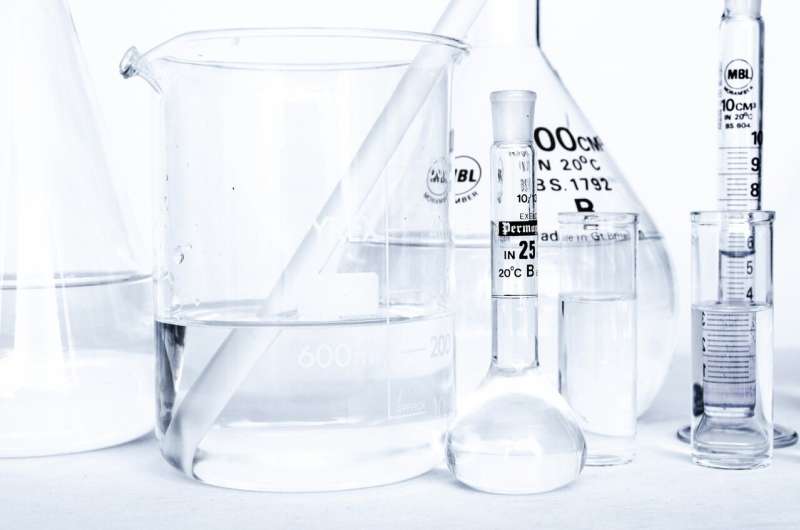Bacterial enzymes 'hijacked' to create complex molecules normally made by plants

Chemists at Scripps Research have efficiently created three families of complex, oxygen-containing molecules that are normally obtainable only from plants.
These molecules, called terpenes, are potential starting points for new drugs and other high-value products—marking an important development for multiple industries. In addition, the new approach could allow chemists to build many other classes of compounds.
The chemistry feat is detailed in the Aug. 13 edition of the journal Science.
The key to this new method of making molecules is the harnessing, or hijacking, of natural enzymes—from bacteria, in this case—to assist in complex chemical transformations that have been impractical or impossible with synthetic chemistry techniques alone, says principal investigator Hans Renata, Ph.D., an assistant professor in the Department of Chemistry at Scripps Research.
Natural enzymes that help build molecules in cells usually perform only one or two highly specific tasks. But the Scripps Research team showed that natural enzymes, even without modification, can be made to perform a wider range of tasks.
"We think that in general, enzymes are a mostly untapped resource for solving problems in chemical synthesis," Renata says. "Enzymes tend to have some degree of promiscuous activity, in terms of their ability to spur chemical reactions beyond their primary task, and we were able to take advantage of that here."
Tapping into enzymes' hidden talents
Enzymes help build molecules in all plant, animal and microbial species. Inspired by their efficiency in constructing highly complex molecules, chemists for more than half a century have used enzymes in the lab to help build valuable compounds, including drug compounds—but usually these compounds are the same molecules the enzymes help build in nature.
Harnessing natural enzymes in a broader way, according to their basic biochemical activity, is a new strategy with vast potential.
"Our view now is that whenever we want to synthesize a complex molecule, the solution probably already exists among nature's enzymes—we just have to know how to find the enzymes that will work," says senior author Ben Shen, Ph.D., chair of the Department of Chemistry on the Florida campus and director of Scripps Research's Natural Products Discovery Center.
The team succeeded in making nine terpenes known to be produced in Isodon, a family of flowering plants related to mint. The complex compounds belong to three terpene families with related chemical structures: ent-kauranes, ent-atisanes, and ent-trachylobanes. Members of these terpene families have a wide range of biological activities including the suppression of inflammation and tumor growth.
A recipe for synthesis success
The synthesis of each compound, in less than 10 steps for each, was a hybrid process combining current organic synthesis methods with enzyme-mediated synthesis starting from an inexpensive compound called stevioside, the main component of the artificial sweetener Stevia.
The chief hurdle was the direct replacement of hydrogen atoms with oxygen atoms in a complex pattern on the carbon-atom skeleton of the starting compound. Current organic synthesis methods have a limited arsenal for such transformations. However, nature has produced many enzymes that can enable these transformations—each capable of performing its function with a degree of control unmatched by man-made methods.
"Being an interdisciplinary research group, we were fully aware of the limitations of current organic synthesis methods, but also of the many unique ways that enzymes can overcome these limitations—and we had the insights to combine traditional synthetic chemistry with enzymatic methods in a synergistic fashion," Renata says.
The three enzymes used, which were identified and characterized by Shen, Renata and colleagues only last year, are produced naturally by a bacterium—one of the 200,000-plus species in the Microbial Strain Collection at Scripps Research's Natural Products Discovery Center.
"We were able to use these enzymes not only to modify the starting molecules, or scaffolds as we call them, but also to turn one scaffold into another so that we could transform a terpene from one family into a terpene from a different family," says second author Emma King-Smith, a Ph.D. student in the Renata lab.
The chemists now intend to use their new approach to make useful quantities of the nine compounds, as well as chemical variants of the compounds, and, with collaborating laboratories, explore their properties as potential drugs or other products.
"With our strategy, we can make these highly oxidized diterpenes much more easily and in larger quantities than would be possible by isolating them from the plants where they are found naturally," says first author Xiao Zhang, Ph.D., a postdoctoral research associate in the Renata lab.
Just as importantly, the researchers say, they are working to identify reactions and enzymes that will allow them to extend their approach to other classes of molecules.
Central to all these efforts is the ongoing development of methods to sift through the DNA of microbes and other organisms to identify the enzymes they encode—and predict the activities of those enzymes. Billions of distinct enzymes exist in plants, animals, and bacteria on Earth and only a tiny fraction of them have been cataloged to date.
"We're excited about the potential of discovering new and useful enzymes from our strain library here at Scripps Research," Renata says. "We think that will enable us to solve many other problems in chemical synthesis."
More information: "Divergent synthesis of complex diterpenes through a hybrid oxidative approach" Science (2020). science.sciencemag.org/cgi/doi … 1126/science.abb8271
Journal information: Science
Provided by The Scripps Research Institute




















